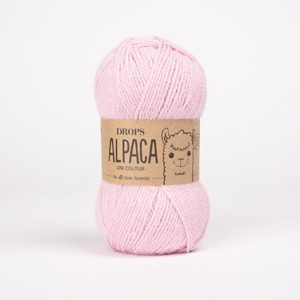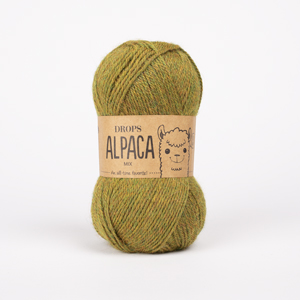Comments / Questions (22)
![]() Bresson wrote:
Bresson wrote:
Pourrais je avoir les explications de ces deux modèles. Merci
18.11.2024 - 12:45DROPS Design answered:
Bonjour Mme Bresson, retrouvez les explications de cet ensemble ici en français. Bon tricot!
18.11.2024 - 16:17
![]() Francesca Saddi wrote:
Francesca Saddi wrote:
Salve vorrei sapere se questo berretto si può realizzare con i ferri normali (non a doppia punta).. grazie x l'attenzione... cordiali saluti Francesca Saddi.
14.12.2018 - 17:49
![]() Francesca Saddi wrote:
Francesca Saddi wrote:
Salve vorrei sapere se questo berretto si può realizzare con i ferri normali (non a doppia punta).. grazie x l'attenzione... cordiali saluti Francesca Saddi.
14.12.2018 - 16:23DROPS Design answered:
Buongiorno Francesca. Può lavorare il berretto anche avanti e indietro sui ferri normali. Aggiunga 1 m per parte per la cucitura. Buon lavoro!
14.12.2018 - 17:18
![]() Henriette wrote:
Henriette wrote:
Ich arbeite zum ersten Mal mit Alpaca-Wolle. Sie ist traumhaft weich. Nun meine Frage: oben sind 7 Größen angegeben: für 1 Monat, 3 - 6 Monate, 9 - 12 Monate, 18 Monate und in der Klammer: 2 - 3 Jahre, 4 - 5 Jahre und 6 Jahre. Im Text gibt es aber nur 6 verschiedene Größenangaben. Welche ist n un welche?
25.12.2017 - 16:26DROPS Design answered:
Libe Henriette, so liest man die verschiedenen Größe: 1. Größe = 1/3 Monage, 2. Größe = 6/9 Monate, 3. Größe = 12/18 Monage, 4. Größe = 2 Jahre, 5. Größe= 3/4 Jahre und 6. Größe = 5/6 Jahre. Viel Spaß beim stricken!
02.01.2018 - 08:20
![]() Kiki Andersson wrote:
Kiki Andersson wrote:
Stickar baby 1911 kragen och har kommit till: när arbetet mäter... tex. 7cm, och ska öka det 1m i varje am-parti genom att sticka 2m i första am= (i mitt fall) 84m .. Upprepa ökningen i växelvis sista o första am i varje am partiosv... Fattar inte hur resår stickningen kommer att funka i resterande varv. Även sista stycket fortsätt sedan med 3rm/ 10 am tills arbetet mäter. Hoppas på hjälp Kiki
15.08.2017 - 17:57DROPS Design answered:
Hej! Varje gång du ökat i de aviga partierna ska de ökade maskorna stickas aviga, dvs. det blir 3 rm/4 am efter första ökningen, 3 rm/5 am efter andra ökningen osv.
17.08.2017 - 14:23
![]() Giovanna wrote:
Giovanna wrote:
Salve. Vorrei sapere se e' possibile eseguire questo modello con i ferri diritti invece che circolari. Graziee
15.11.2015 - 06:52DROPS Design answered:
Buongiorno Giovanna, abbiamo risposto alla sua domanda precedente. Entrambi i modelli sono lavorati in tondo: se vuole usare i ferri dritti, può aggiungere una maglia di vivagno al centro dietro e lavorare avanti e indietro, stando attenta alla lavorazione. Buon lavoro!
16.11.2015 - 18:10
![]() Giovanna wrote:
Giovanna wrote:
Salve. Vorrei sapere se e' possibile eseguire questo modello con i ferri diritti invece che circolari. Graziee
14.11.2015 - 19:01DROPS Design answered:
Buonasera Giovanna, entrambi i modelli sono lavorati in tondo: se vuole usare i ferri dritti, può aggiungere una maglia di vivagno al centro dietro e lavorare avanti e indietro, stando attenta alla lavorazione. Buon lavoro!
14.11.2015 - 22:23
![]() PROVOST wrote:
PROVOST wrote:
Bonjour, pour le bonnet si on a 70 mailles à répartir sur 4 aiguilles comment peut on avoir 14 par aiguilles ?
16.12.2014 - 18:58DROPS Design answered:
Bonjour Mme Provost, erreur de calcul ... répartissez les 70 m de façon la plus équilibrée: 70/4=17.5, donc vous aurez 2 aiguilles avec 17 m chacune et 2 aiguilles avec 18 m chacune = 70m. Bon tricot!
17.12.2014 - 09:36
![]() PROVOST wrote:
PROVOST wrote:
Merci beaucoup pour vos explications.
10.12.2014 - 20:53
![]() PROVOST wrote:
PROVOST wrote:
Bonjour, pour le bonnet, on monte les 6 mailles sur 1 aiguille double pointe, on tricote un cache oreille sur une 2eme, on monte les 18 mailles sur une 3eme, le 2eme cache oreille sur une 4eme et les 6 autres dernières mailles ? Avec les 6 premières ? Merci.
10.12.2014 - 15:56DROPS Design answered:
Bonjour Mme Provost, pour le bonnet, les tours commencent au milieu dos: on monte 6 m, puis on tricote le 1er cache-oreille, on monte 18 m pour le devant, on tricote le 2e cache-oreille et on monte 6 m (fin du tour) - on va avoir 12 m entre les 2 cache-oreilles au milieu dos, et un total de 70 m (taille 6/9 mois) à répartir sur 4 aiguilles soit 14 m par aig - notez bien que le début des tours se trouve au milieu dos (avant les 6 premières m montées) et se termine par les 6 dernières m montées. Bon tricot!
10.12.2014 - 18:10
Baby Noel#babynoelset |
|
 |
 |
Set of knitted Santa hat and neck warmer for baby and children in 2 threads DROPS Alpaca
DROPS Baby 19-11 |
|
|
NECK WARMER: Size: 1/3-6/9-12/18 months (2-3/4-5/6) years Materials: DROPS ALPACA from Garnstudio 50-50-50 (50-100-100) g color no 3620, red. 50 g for all sizes color no 1101, white DROPS CIRCULAR NEEDLE (40 cm / 16") size 5 mm/ US 8 – or size needed to get 17 sts x 22 rows in stockinette st with 2 strands Alpaca = 10 x 10 cm / 4" x 4". DROPS CROCHET HOOK size 4.5 mm / US 7 - for crochet border. -------------------------------------------------------- HAT: INCREASING TIP: Inc 1 st inside 1 edge st by making 1 YO. On next row work YO into back of loop to avoid a hole. GARTER ST (back and forth on needle): K all rows. GARTER ST (in the round): K 1 round, P 1 round. -------------------------------------------------------- -------------------------------------------------------- HAT: Beg with the ear flaps, worked back and forth on double pointed needles, then cast on sts for the hat and work hat in the round on double pointed needles. EAR FLAP: Worked back and forth on double pointed needles. Cast on 6-6-6 (6-6-7) sts on double pointed needles size 5 mm / US 8 with 2 strands white. Work GARTER ST – see above – back and forth on needle (first row = RS). AT THE SAME TIME on row 3 inc 1 st each side - See INCREASING TIP – and repeat the inc on every other row a total of 5-6-7 (7-8-8) times = 16-18-20 (20-22-23) sts. After the last inc piece measures approx 3.5-4-4.5 (4.5-5-5) cm / 1¼"-1½"-1¾" (1¾"-2"-2"). Work 1 row from WS, AT THE SAME TIME inc 2-2-2 (4-4-4) sts evenly = 18-20-22 (24-26-27) sts. Slip sts on a stitch holder and knit one more ear flap. HAT: Worked in the round on double pointed needles. Cast on 6-6-5 (5-4-4) sts on double pointed needles size 5 mm / US 8 with 2 strands white, work 1 ear flap in on double pointed needles (= 18-20-22 (24-26-27) sts), cast on 17-18-18 (19-20-20) sts (= front), work the other ear flap in on double pointed needles (= 18-20-22 (24-26-27) sts) and cast on 6-6-5 (5-4-3) sts = 65-70-72 (77-80-81) sts on needle. Insert a marker, and now measure piece from here. Continue in GARTER ST – see above – until piece measures 5-5-6 (6-7-8) cm / 2"-2"-2⅜" (2⅜"-2¾"-3⅛") from marker. Now continue in stockinette st with 2 threads red. When piece measures 9-10-11 (13-15-18) cm / 3½"-4"-4⅜" (5⅛"-6"-7") from marker insert 5-5-6 (7-8-9) new markers in piece with 13-14-12 (11-10-9) sts between each. Now dec 1 st after each marker by K2 tog (i.e. = 5-5-6 (7-8-9) dec sts per round). Dec like this on every other round a total of 11-12-11 (10-9-8) times = 10-10-6 (7-8-9) sts left on needle. Now K2 tog all the way round = 5-5-3 (4-4-5) sts. Cut the thread, pull it through remaining sts, tighten and fasten. Hat measures approx 19-20-21 (22-23-24) cm / 7½"-8"-8¼" (8¾"-9"-9½") from marker mid back. CROCHET BORDER: Crochet a border round the edge of hat from RS with hook size 4.5 mm/ US 7 and 2 threads white as follows: 1 sc at the point of one ear flap and continue as follows: * 3 ch, 1 dc in the first of the 3 ch, skip approx 1 cm / ⅜", 1 sc in next st *, repeat from *-* and finish with 3 ch, 1 dc in the first of the 3 ch and 1 sl st in sc from beg of round. Cut and fasten thread. POMPOM: Make 2 pompoms with a diameter of approx 5 cm / 2" with white. Sew 1 pompom to the point of each earflap. -------------------------------------------------------- NECK WARMER: Worked in the round on circular needle from top down. Cast on 54-66-72 (84-96-102) sts on circular needle size 5 mm / US 8 with 2 strands red. Work 2 rows GARTER ST – see above – and continue in rib K3/ P3. When piece measures 5-6-7 (7-8-8) cm / 2"-2⅜"-2¾" (2¾"-3⅛"-3⅛") inc 1 st in each P-section by working 2 sts in the first P-st = 63-77-84 (98-112-119) sts. Repeat the inc in the last and first P-st alternately in each P-section on every 2-2-2 (3-3-3) round another 6-6-6 (5-5-5) times = 117-143-156 (168-192-204) sts. Continue with K3/P10-10-10 (9-9-9) until piece measures 11-12-13 (15-17-18) cm / 4⅜"-4¾"-5⅛" (6"-6¾"-7"). Now change to 2 threads white. Work 2 cm / ¾" garter st and bind off. CROCHET BORDER: Crochet a border round bottom edge from RS with crochet hook size 4.5 mm / US 7 and 2 threads white as follows: 1 sc, * 3 ch, 1 dc in the first of the 3 ch, skip approx 1 cm / ⅜", 1 sc in next st *, repeat from *-* and finish with 3 ch, 1 dc in the first of the 3 ch, skip approx 1 cm / ⅜" and 1 sl st in sc from beg of round. Cut and fasten thread. |
|
Have you finished this pattern?Tag your pictures with #dropspattern #babynoelset or submit them to the #dropsfan gallery. Do you need help with this pattern?You'll find 21 tutorial videos, a Comments/Questions area and more by visiting the pattern on garnstudio.com. © 1982-2025 DROPS Design A/S. We reserve all rights. This document, including all its sub-sections, has copyrights. Read more about what you can do with our patterns at the bottom of each pattern on our site. |
|
























































Post a comment to pattern DROPS Baby 19-11
We would love to hear what you have to say about this pattern!
If you want to leave a question, please make sure you select the correct category in the form below, to speed up the answering process. Required fields are marked *.